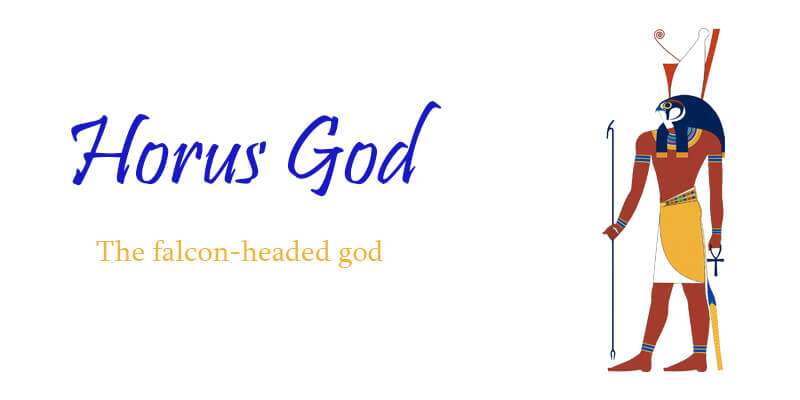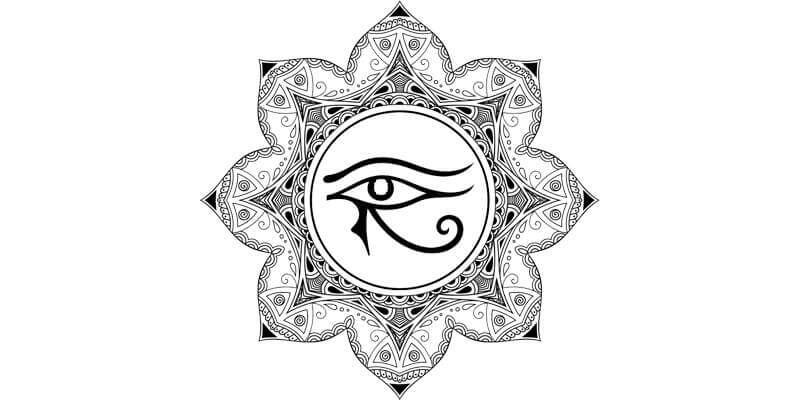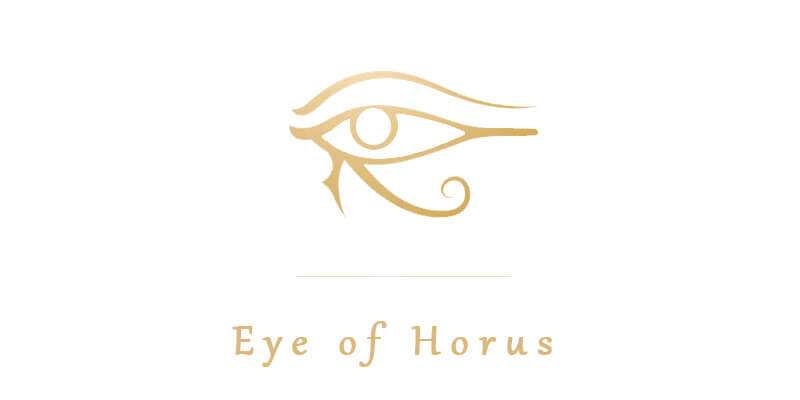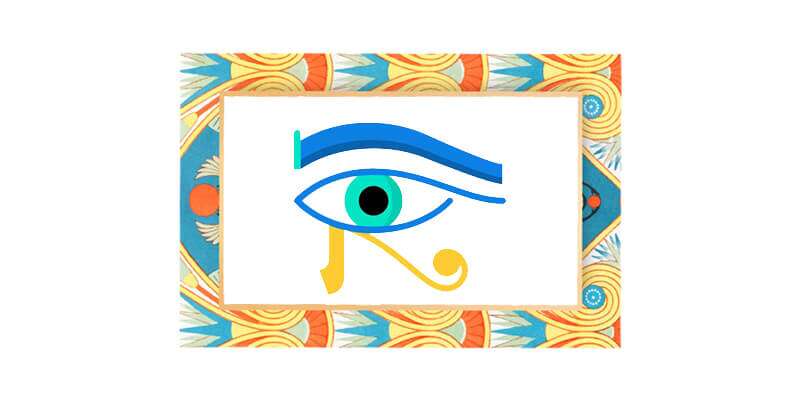This Eye of Horus symbol meaning became a symbol of healing and completion but is also a symbol of light, offerings, protection, and perfection. The mythology of Isis, Osiris, and Horus is likely one of the best-known ancient Egyptian myths. The culture of ancient Egypt is one of the oldest in human history. The ancient Egyptians were ahead of their time in art, medicine, and writing down their discoveries as myths.
The Egyptians were experts at making symbols and figures that showed both anatomy and mythology. The Eye of Horus is the left moon eye of Horus, the god of light, healed and restored by Thoth, the god of magic and healing, after his adversary Seth, the god of darkness, smashed it in battle. But instead of using it himself, Horus sacrificed it to his father, Osiris, as his third eye. In doing so, he awakened a new consciousness in Osiris, the god of the dead, and shed light on the darkness of the underworld.
If you’re looking to discover more about the Eye of Horus meaning spiritual and ancient Egyptian check out our Egypt Excursions.
Who is God Horus?

In the religion of ancient Egypt, Horus was seen as a god with a falcon-headed He is now a common symbol of Egypt, and you can see him on everything from the planes of Egyptian airlines to the furniture in Egyptian hotels and restaurants. Horus is the third and last member of the holy child triad and the son of Osiris and Isis. Eye of Horus Amulet according to Egyptian mythology, the wedjat vision is a sign of power to grow back and a fresh start.
Don’t miss to check out our article about Egyptian Amulets and their meanings
Origins of Eye of Horus

The Eye of Horus, which came from the story of Isis and Osiris, The Eye of Horus magic was a sign of good luck and safety. This symbol has a significant link between the structure and function of the brain. From an artistic point of view, the eye has six different parts. From the point of view of mythology, each part of the eye is a separate symbol. Also, parts of the eye represent the numbers 1/2, 1/4, 1/8, 1/16, and 1/32. When this image is put on top of a sagittal image of the human brain, it looks like each part corresponds to the anatomical position of a different human sensorium.
In this article, we talk about what scientists might think about how smart it was for the ancient Egyptians to understand the human body so well.
Introduction and History of Horus’s Eye

The ancient Egyptians came up with many ideas that led to the creation of modern systems and tools that are used daily today. Some of these innovations are discoveries about the human body and medicine that led to techniques and tools still used in surgery today. The Egyptians wrote down many findings by mixing facts with myths and mystical ideas.
We looked for information about neuroanatomy, the eye of Horus, and the neuroanatomical basis for the Eye of Horus in the PubMed database, National Geographic Magazine, medical and anatomical history books, and Google Scholar. We tried to find original articles or experiments that showed how the Eye of Horus works in the brain.
The ancient Egyptians were experts at using their knowledge of anatomy and mythology to make symbols and figures in their art. From an artistic point of view, the eye has six different parts, and each piece is a separate symbol. From a mythological point of view, each component is the center of a different human sensorium.
The ancient Egyptians saw the Eye of Horus as a sign of prosperity and safety for a long time, and this tradition lives on in modern Egypt. But when you look more closely at its artistic design and learn the epic story behind how he made it, the eye stops being a unique mythological symbol. It becomes a striking example of how well the ancient Egyptians understood how the human body works.
Background and Mythology Eye of Horus

The story of Osiris is where the myth of the Eye of Horus starts. In ancient Egypt, this story was the most well-known myth. It shows how the good, the bad, and the punishment are constantly at odds with each other. Osiris was the oldest son of Geb, the god of the earth, and Nut, the goddess of the sky. He was known as the god of the underworld, but he was better known as the god of change, resurrection, and rebirth.
Isis, Set, and Nephthys were Osiris’s three siblings. As was the norm then, Osiris married his sister Isis, and they had a son named Horus. Set, Osiris’s brother, killed Osiris so that he could take the throne, and it caused chaos and disorder in ancient Egypt.
Set didn’t stop being cruel after killing Osiris. He then cut Osiris’ body into 14 pieces and spread them all over ancient Egypt. According to ancient Egyptian traditions, the body had to be correctly embalmed and buried in the royal tombs for a king’s spirit to pass to the underworld. It allowed the body to go through the underworld’s gates and be judged based on what it had done in life.
Isis goes on a trip with Horus to find Osiris’s body parts. Isis also asked her sister Nephthys and Nephthys’s son, Anubis, for help. Anubis was the son of Nephthys and Osiris. It is said that Nephthys posed as Isis to trick Osiris into giving birth to Anubis. Isis, Nephthys, Anubis, and Horus found the parts of Osiris.
Then, Osiris’s spirit could go to the underworld, called Amenti, and rule over the dead. When Horus killed Set in the big battle at Edfu, he announced his rule over Egypt and put things back in order.
The Egyptians were ahead of their time in art and medicine, and it is clear from how the Eye of Horus is made. He broke the Eye of Horus into six parts called “Heqat fractions.” Each part was seen as a symbol on its own. Heqat is one of the oldest ways Egyptians measured things. In this system, numbers are seen as patterns that go in order.
Gay Robins and Charles Shute discussed this idea when they talked about the mathematical measurements of ancient Egypt in the “Rhind Mathematical Papyrus,” which is thought to be the oldest mathematical writing. In the Rhind Mathematical Papyrus, the heqat was described as a volume unit used to measure things like grain and flour, and it was thought to be about 4.8 liters or a little more than a gallon.
Divisions of the Eye of Horus

They assembled the fragments of the Eye of Horus to form the whole eye, similar to the myth. They gave these fragments a series of numerical values with a numerator of one and dominators to powers of two: 1/2, 1/4, 1/8, 1/16, 1/32, and 1/64. Some historians thought each part of the eye represented one of the six senses: smell, sight, thought, hearing, taste, and touch.
The 1/2 is for taste, the 1/4 is for sight, the 1/8 is for thought, the 1/16 is for hearing, the 1/32 is for smell, and the 1/64 is for touch. Surprisingly, when we put these proposed parts on top of the average sagittal image of the human brain, each piece matches a part of the brain’s anatomy.
Smell: 1/2
To show how vital the Eye of Horus is to human neuroanatomy, we look beyond the visual world and into the hidden mysteries of the human senses, starting with the smell. On the Eye of Horus, the triangle on the right side of the pupil of the eye, which is yellow, stands for the sense of smell.
The ancient Egyptians saw this battle as a symbol of the fight between good and evil and between order and chaos. After that, the ancient Egyptians worshipped Horus in the form of the Eye of Horus, which was seen as a sign of prosperity and safety.
On closer inspection, they made this triangular object look like the side view of a human nose as a symbol of smell. They gave it the fraction 1/2 Heqat. The 1/2 Heqat fraction is also in the same place as the olfactory trine and has the same shape.
Sight: 1/4
When light hits the retina inside the eyeball, it sends electrical impulses through the optic pathways to the inter thalamic adhesion (Massa intermedia). Some thalamic fibers that carry the vision and other sensations move to the midline and then curve laterally to the same thalamus.
The thalamus sends impulses to the optic radiation pathways, sending them to the occipital lobe’s visual cortex. The 1/4 Heqat fraction is on the pupil of the eye of Horus, which stands for sight or the feeling of seeing.
The Massa intermedia (inter thalamic adhesion) was the visual center, but there needs to be more evidence to support our theory. 1/4 Heqat is also in the same place and shape as the Massa intermedia (inter thalamic adhesion).
Wisdom: 1/8
One of the symbolic names for the Eye of Horus is “Eye of the Mind,” which comes from the idea that it represents Wisdom or thought. The eyebrow of the eye is a symbol of Wisdom, and it gets 1/8 of the Heqat.
People often think of the eyebrow as a sign of thought. For example, we move our eyebrows to show how we feel. From a medical point of view, it is similar to the corpus callosum.
The corpus callosum is the brain’s largest group of white matter fibers, and it helps nerve impulses move quickly between the two sides of the brain. The eyebrow on the Eye of Horus stood for Wisdom and got the 1/8 Heqat fraction. The location and shape of the 1/8 Heqat fraction are very similar to those of the corpus callosum.

Hearing: 1/16
Brodmann areas 41 and 42 comprise the primary auditory cortex of the temporal lobe. They are found in the anterior transverse temporal lobe (Brodmann area 41) and the posterior transverse temporal lobe (Brodmann area 42). (Brodmann area 42). On the eye of Horus, the triangle-shaped object represents hearing, and the lateral commissure (canthus) on the left side of the pupil of the eye is shown by the cyan triangle with dots and the dotted line that connects it. This area got 1/16 Heqat. The 1/16 Heqat fraction is in the same place as Brodmann areas 41 and 42 and has the same shape.
Taste: 1/32
The thalamus sends the taste sensation to the primary taste area of the cerebral cortex, where it is interpreted. The curved tail shows taste on the eye of Horus, which has the 1/32 Heqat fraction. The part of the eye that is 1/32 Heqat is like the taste pathway in the human brain, and ancient Egyptians used this fraction as part of their mystical arts.
Touch: 1/64
The somatosensory pathway sends touch signals. This pathway also signals pain, pressure, temperature, joint and muscle position sense, and light touch (proprioception).
There are three groups of these feelings, and each group is sent to a different part of the cortex by a different path in the spinal cord.
The first group includes the senses of touch, pressure, and vibration, which help us figure out the shapes and textures of things even when we can’t see them. The posterior column-medial lemniscus pathway of the spinal cord is in charge of these senses.
The lateral spinothalamic tract sends pain and temperature sensations to the second group. The third group is proprioception, which lets us know where our body parts are about each other and how much force we need to move.
On the eye of Horus, the straight object coming down from the right side of the eye represents the sense of touch, and it got the 1/64 Heqat fraction. The somatosensory pathway is like the 1/64 Heqat fraction of the eye.
Conclusion – Eye of Horus

Even though we know it’s possible to read too much into a symbolic masterpiece like the Eye of Horus, the anatomical metaphors in the Eye of Horus are not by chance and should be discussed. The Egyptians were ahead of their time in medicine and anatomy. It is written on the walls of many temples and tombs and on papyrus that has been found.
Ancient Egyptians used their art skills, knowledge of anatomy, and strong belief in mythology to make the Eye of Horus. More importantly, we say that their ideas about how humans sense things have an apparent effect on the size and shape of the eye.
It is a great accomplishment, especially since X-rays and computers did not exist then. Our theory about the Eye of Horus is not a gold standard for anatomy. Instead, it is a way to recognize and honor the genius and foresight of an ancient culture that was able to figure out how the complex functions of the human central nervous system work.
Explore Egypt with our Travel Packages
Find out about Ancient Egypt Pharaohs, Ancient Egypt Facts, Pharaohs, and Kings by booking the Best Egypt Vacations Packages & Cairo Excursions to the Pyramids of Giza, the Great Sphinx, and many more. Also Egypt Nile Cruise to Luxor and Aswan Attractions. Luxor Excursions to Valley of the Kings, Hatshepsut Temple, and Karnak Temple. Packages for Family, Honeymoon & Solo travel tours to Explore Egyptian Sightseeing to learn about hidden secrets symbols and amulets.



0 Comment